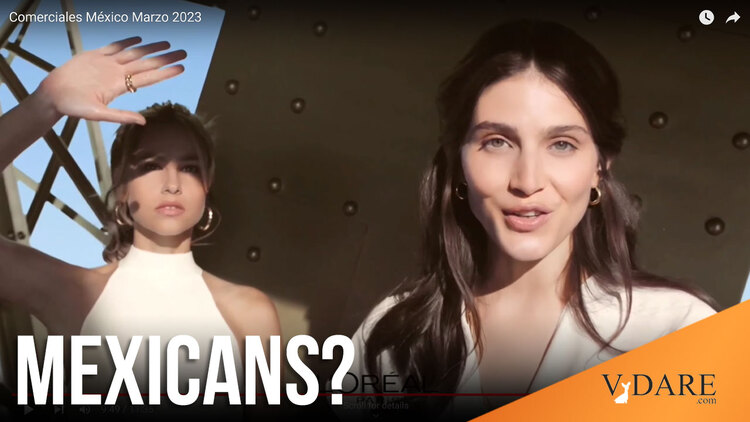


By Allan Wall
08/07/2023
Above, a commercial for L'Oreal shot in Paris featuring white Spanish-speaking actresses.
A recent VDARE.com article by Carl Horowitz — Blacks Can Sell Anything: TV Commercials As Race Replacement — discussed the overwhelming preponderance of black actors in commercials on American television, much greater than the black proportion of the U.S. population. This goes hand in hand with anti-white Regime Media bias and presages the U.S. government’s deliberate demographic transformation of the country through immigration policy. But, in dramatic contrast, Mexican commercials still show a marked preference for whites (cf. Latin American Beauty Queens), although whites are a minority in Mexico. But no one in Mexico is working to Elect A New People anyway.
Horowitz captured what’s going on in the U.S. with a quotation from advertising consultant Daren Poole: “Rather than being a mirror on society, advertising has an ability to shape it.”
This propaganda has been going on for a long time. Way back in 2002, VDARE.com received a letter from a teacher in the Czech Republic, who shared with us that his students think the U.S. black population is much higher than it actually is. The teacher would ask his classes what proportion of the U.S. population was black, and would get answers from a low of 20% to a high of 60%, with about a 35% average. His explanation:
In my opinion, the U.S. entertainment media’s ceaseless presentation of blacks in disproportionate numbers, as lawyers, doctors, high government officials and detectives chasing white violent criminals, as seen on Czech television, of course all of it dubbed, eventually skews even intelligent minds.
Our Czech correspondent closed his letter with this pertinent observation:
The influence of all pervasive sustained propaganda ought not to be underestimated — as many in this country who have experienced 40 years of communism can testify.
“Communism” — there’s that word again!
Regardless, in Mexico, whites are still seen as an aesthetic ideal. Of course, there are professional American-based Hispanics eager to tell the gringo Leftists what they want to hear:
In recent years, the advertising industry has witnessed a much-needed shift toward embracing diversity and representation. Latin America, a region rich in cultural heritage and diversity, is no exception. Brands are realizing the importance of showcasing “real people” to better connect with their target audience. In doing so, they not only enhance their brand image but also promote inclusivity and equality.
[Bridging Cultures, Shaping Narratives: Embracing Diversity And Representation In Latin American Advertising, by Salvador Ordorica, Forbes, July 20, 2023]
Specifically regarding Mexico, Ordorica had this to say:
Before 2020, I saw many advertisements in Mexico that predominantly featured white models, which did not accurately represent the majority of Mexicans, known as ‘morenos’ [dark], who have a range of skin tones. This lack of representation again can create a sense of exclusion and contribute to the perpetuation of colorism.
“Before 2020”? But a recent survey of Mexican advertising I conducted indicates that it hasn’t changed that much. And I doubt there’s as much pressure in Mexico (where I lived for many years) to change it anyway.
Due to the manner in which Mexico was settled 500 years ago, the country’s population is a spectrum, with whites on one end, Indians on the other, with the majority of the population comprised of mestizos, who derive from both Indian and European ancestors.
Most Mexicans are mixed-race. However, that doesn’t mean race isn’t important. Mexico is a racially stratified society, a fact many Mexicans have denied, but which is finally getting more publicity.
For the vast stretch of Mexico’s modern history, many denied that racism existed in the country at all.
But a growing social movement is challenging that thinking, bringing discussions of discrimination based on skin color to the fore. https://t.co/IDrcTU5OVK
— Los Angeles Times (@latimes) October 20, 2022
There are exceptions, but the higher one goes up the socioeconomic ladder the whiter the Mexicans are; the lower one goes the darker the Mexicans are.
And traditional European standards of beauty are still ascendant. This is 2010’s Miss Mexico, who went on to win Miss Universe:

In order to evaluate the current state of Mexican advertising, I viewed several hundred commercials produced this year, in 2023, which were broadcast in the central Mexican city of Puebla from January to July. If you’d like to view the same ads, here they are: January, February, March, April, May, June, July.
As I viewed the advertisements, I quickly wrote down the product advertised and the racial breakdown of the people in the ad.
My definition of white was very simple: Do they look white? Do they look like people of European descent? Of course white people may have some non-white ancestry, but they’re still mostly European.
My conclusion after viewing all these ads: Mexican commercials are still dominated by European-origin actors. I saw more whites than mestizos, and I saw more mestizos than any other race.
A few examples:
Last year Tecate featured Bruce Willis in one of its commercials (with five white Mexican beer drinkers), in which he said “Fria” (cold).
So the majority of the actors I saw in the Mexican commercials were of European origin, followed by mestizos, with very few Indians and even fewer blacks.
Wouldn’t American racial agitators have a heyday in Mexico?
In Mexico, governments and government agencies run their own ads, supported by the public budget, to advertise what great things they are doing. These governmental ads, in general, seemed to have a higher percentage of darker-skinned Mexicans, usually not actors.
Does that imply that only white people care about equality of the sexes and sexual harassment? Or that only white people need to be lectured on them and non-whites don’t?
Or am I overthinking this?
Another interesting detail: every time I saw a doctor or health professional portrayed — in commercials for Alliviax, L’Oreal, Oral B, Dolo-Neurobion, and Alli-Triple, below — he or she was white.
Can you imagine that in the U.S.?
Another detail. Ads for beauty products overwhelmingly featured white women, like this L’Oreal commercial filmed in Paris. (L’Oreal is a French company, but the models are speaking Spanish.)

See more beauty product ads here, here, here, here, and here.
The most entertaining ad I viewed was El Gran Escape (the Great Escape), released in June of 2023.
It was a commercial for Sabritas, which has already cornered over 80% of the Mexican potato chip market.
El Gran Escape features none other than Shakira, a Colombian pop star of Lebanese/Spanish descent. The ad was filmed in Barcelona, Spain, designed for a Mexican audience [Shakira’s exciting commercial for Sabritas and Lay’s, ESlogan magazine, June 22, 2023].
Spoiler alert, in case you haven’t yet watched the video: Weary of the pressures of stardom, Shakira eats Sabritas potato chips and goes wild, escaping in an RV, speeding through Barcelona, barely missing being hit by a train, and arriving at the Mediterranean where she can eat her Sabritas in peace.
All the principals are white: Shakira herself, her female agent, the guy with a megaphone, the two showbiz lawyer-types who follow her in an automobile, the male reporter and the anchorwoman, they’re all white.
But why can’t commercials be fun and non-PC — like American commercials in the 1970s?
My conclusion: Mexican advertising is a dynamic enterprise producing entertaining commercials designed to sell products. Most of the actors in Mexican commercials are Euro-Mexicans, and secondarily Mestizos, perhaps because that’s where most of the consumer money is. But Mexicans don’t seem to mind.
As time goes by, more Indians and Afro-Mexicans will probably be included in commercials, and that’s fine. It ought to be a gradual process and not some revolutionary transformation.
But Mexico’s advertising industry has not been taken over by fanatics. At least not yet.
American citizen Allan Wall (email him) moved back to the U.S.A. in 2008after many years residing in Mexico. Allan‘s wife is from Mexico and is now a U.S. citizen, their two sons are bilingual. In 2005, Allan served a tour of duty in Iraq with the Texas Army National Guard. His VDARE.com articles are archived here; his Border Hawk blog archive is here, his website is here.